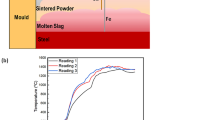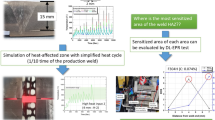Abstract
The article considers the temperature distribution in steel at its continuous teeming. The temperatures were measured sequentially in the steel-teeming ladle (one measurement) and the tundish (two measurements) using a platinum-platinum-rhodium thermocouple with an accuracy of ±4°C. This work analyzes the results of 170 casts of grade 5SP and 35GS steels. The type of temperature set distribution was checked against three goodness-of-fit criteria: Pearson χ-square test, Kolmogorov–Smirnov test λ and Shapiro–Wilk test W. It is shown that the temperatures in the steel-teeming ladle for various kinds of steel fit within the normal distribution model. The results obtained are consistent with the physics of steel casting. The metal in the steel-teeming ladle is practically stable and subject only to natural cooling through the lining, top and body of the ladle. However, in case of analyzing a sample of temperatures in the tundish at the first and second measurement, the normal distribution hypothesis should be rejected. Here, the steel temperature depends on a number of parameters, including the feed rate, casting rate, feed time, composition of slag-forming and heat-insulating mixtures, and others. The attempts to establish the relationship between the steel temperatures in the steel-teeming ladle and in the tundish were unsuccessful. Considering the temperature measurements in the tundish as two sequential data arrays, the first of which is an argument, and the second is a function, a linear relationship between the arrays is established. This relationship can be used to estimate the final steel temperature at the dropout of thermocouple readings, including in the event of a failure. The results of the work can be used in developing a mathematical model of steel teeming.



Similar content being viewed by others
REFERENCES
Amelin, A.V., Shchipanov, S.S., Amelin, Al.V., and Foigt, D.B., Development of steel continuous casting in AO EVRAZ-ZSMK, Stal’, 2019, no. 7, pp. 14–16.
Han, Z., Li, Y., Yang, M., Yuan, Q., Ba, L., and Xu, E., Digital twin-driven 3D visualization monitoring and traceability system for general parts in continuous casting machine, J. Adv. Mech. Des., Syst., Manuf., 2020, vol. 14, no. 7, art. ID 0100. https://doi.org/10.1299/jamdsm.2020jamdsm0100
Yoon, J.-K., Applications of numerical simulation to continuous casting technology, ISIJ Int., 2008, vol. 48, no. 7, pp. 879–884. https://doi.org/10.2355/isijinternational.48.879
Ma, J., Xie, Z., and Jia, G., Applying of real-time heat transfer and solidification model on the dynamic control system of billet continuous casting, ISIJ Int., 2008, vol. 48, no. 12, pp. 1722–1727. https://doi.org/10.2355/isijinternational.48.1722
Grip, C.-E., Simple model for prediction of temperatures in an L-shaped tundish—Verification by continuous temperature measurements, ISIJ Int., 1998, vol. 38, no. 7, pp. 704–713. https://doi.org/10.2355/isijinternational.38.704
Fan, C.-M. and Hwang, W.-S., Mathematical modeling of fluid flow phenomena during tundish filling and subsequent initial casting operation in steel continuous casting process, ISIJ Int., 2000, vol. 40, no. 11, pp. 1105–1114. https://doi.org/10.2355/isijinternational.40.1105
Pardeshi, R., Basak, S., Singh, A.K., Basu, B., Mahashabde, V., Roe, S.K., and Kumar, S., Mathematical modeling of the tundish of a single-strand slab caster, ISIJ Int., 2004, vol. 44, no. 9, pp. 1534–1540. https://doi.org/10.2355/isijinternational.44.1534
Liu, S.-X., Yang, X.-M., Du, L., Li, L., and Liu, C.-Z., Hydrodynamic and mathematical simulations of flow field and temperature profile in an asymmetrical t-type single-strand continuous casting tundish, ISIJ Int., 2008, vol. 48, no. 12, pp. 1712–1721. https://doi.org/10.2355/isijinternational.48.1712
El’darkhanov, A.S., Nuradinov, A.S., and Baranova, V.N., Some aspects of external influences application during continuous casting of steel, Stal’, 2015, no. 10, pp. 17–20.
Botnikov, S.A., Khlybov, O.S., and Kostychev, A.N., Development of a steel temperature prediction model in a steel ladle and tundish in a casting and rolling complex, Steel Transl., 2019, vol. 48, no. 10, pp. 688–694. https://doi.org/10.3103/S096709121910005X
Timoshpol’skii, V.I. and Trusova, I.A., The technological improvement for continuous casting of section steel, and the measuring methods for the temperature during solidification and cooling, Report I, Steel Transl., 2019, vol. 49, no. 11, pp. 783–788. https://doi.org/10.3103/S0967091219110147
van Ende, M.-A. and Jung, I.-H., Development of a thermodynamic database for mold flux and application to the continuous casting process, ISIJ Int., 2014, vol. 54, no. 3, pp. 489–495. https://doi.org/10.2355/isijinternational.54.489
Klimanchuk, V.V., Bochek, A.P., Lavrinishin, S.A., et al., Efficiency of protection of continuously casted metal, Stal’, 2007, no. 1, pp. 20–22.
Toptygin, A.M., Polozov, E.G., Aizin, Yu.M., and Neklyudov, I.V., Improving protective slag-forming mixtures for intermediate ladles of continuous-casting machines, Steel Transl., 2007, vol. 37, no. 3, pp. 266–270. https://doi.org/10.3103/S0967091207030254
Kapitanov, V.A., Kuklev, A.V., and Polozov, E.G., Heat-insulating properties of slag mixtures for the intermediate ladle, Steel Transl., 2009, vol. 39, no. 1, pp. 50–52. https://doi.org/10.3103/S0967091209010124
Vil’danov, S.K., Likhodievskii, A.V., and Pyrikov, A.N., Development and introduction of energy saving materials for steel pouring, Refract. Ind. Ceram., 2011, vol. 52, no. 4, pp. 237–239. https://doi.org/10.1007/s11148-011-9404-z
Vil’danov, S.K., Development and implementation of heat-insulating and slag-forming materials of Isotherm-1600 series, Stal’, 2018, no. 9, pp. 17–22.
Vil’danov, S.K. and Likhodievskii, A.V., RF Patent 2334587.
Vil’danov, S.K., Likhodievskii, A.V., and Pyrikov, A.N., RF Patent 2464122.
Palii, I.A., Prikladnaya statistika (Applied Statistics), Moscow: Vysshaya Shkola, 2004.
Pearson, E.S. and Hartley, H.O., Biometrika Tables for Statisticians, Cambridge: Cambridge Univ. Press, 1954, vol. 1.
Ivchenko, G.I. and Medvedev, Yu.I., Matematicheskaya statistika (Mathematical Statistics), Moscow: Vysshaya Shkola, 1984.
Cox, D.R. and Hinckley, D.V., Theoretical Statistics, Boca Raton, FL: CRC Press, 1979.
Lehman, E.L., Testing Statistical Hypotheses, New York: Wiley, 1959.
Kateman, G. and Pijpers, F.W., Quality Control in Analytical Chemistry, New York: Wiley, 1981.
Karlin, S., First Course in Stochastic Processes, New York: Academic, 1966.
Hald, A., Statistical Theory with Engineering Applications, New York: Wiley, 1952.
Brownlee, K.A., Statistical Theory and Methodology in Science and Engineering, New York: Wiley, 1965.
Kolmogorov, A.N., Teoriya veroyatnostei i matematicheskaya statistika (Probability Theory and Mathematical Statistics), Moscow: Nauka, 1986.
Johnson, N.L. and Leone, F.C., Statistics and Experimental Design in Engineering and the Physical Sciences, New York: Wiley, 1977.
Bocharov, P.P. and Pechinkin, A.V., Matematicheskaya statistika (Mathematical Statistics), Moscow: Ross. Univ. Druzhby Nar., 1994.
Shapiro, S.S. and Wilk, M.B., An analysis of variance test for normality (complete samples), Biometrika, 1965, vol. 52, pp. 591–611. https://doi.org/10.2307/2333709
Cochran, W.G., The χ2 test of goodness of fit, Ann. Math. Stat., 1952, vol. 23, pp. 315–345.
Williams, C.A., On the choice of the number and width of classes for the Chi-Square test goodness of fit, J. Am. Stat. Assoc., 1950, vol. 45, pp. 77–86.
Hahn, G.J. and Shapiro, S.S., Statistical Models in Engineering, New York: Wiley, 1967.
Author information
Authors and Affiliations
Corresponding authors
Additional information
Translated by S. Kuznetsov
About this article
Cite this article
Vil’danov, S.K., Podgorodetskii, G.S. Mathematical Statistics for Measuring Steel Temperature in Steel-Teeming Ladle and Tundish at Continuous Steel Teeming. Steel Transl. 51, 438–445 (2021). https://doi.org/10.3103/S096709122107010X
Received:
Revised:
Accepted:
Published:
Issue Date:
DOI: https://doi.org/10.3103/S096709122107010X




